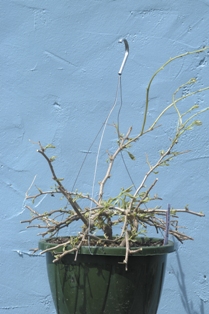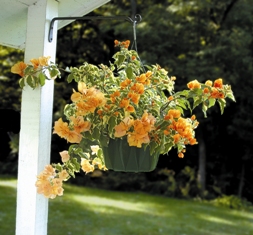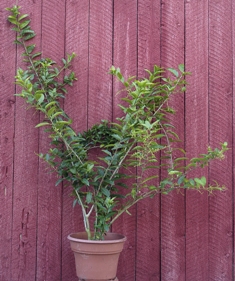
No Room? Try the cellar
By Laurelynn Martin and Byron Martin
 |
|
Bougainvillea 'DeltaDawn' |
 |
|
Same Bougainvillea 'DeltaDawn' |
 |
|
Cestrum Nocturnum at Summer's |
We wouldn’t think of putting our guests in the cellar, but many of our well-loved tropical container plants will actually manage quite well in a cool, dark place to wait out the winter. If you’re like most Logee gardeners, by the time we get to Fall we look with amazement at our huge tropical plants that have been rapidly growing since late Spring. “Now what?” we ask. One solution used more and more is to store your container plants in a cellar, basement or heated garage.
This treatment for holding potted plants through the winter has been used for a long time for plants like brugmansias and taro roots; colocasia and xanthosoma. The process is similar to the wintering over of cannas and dahlias except that, with tropical plants, moisture must be given to the root system.
Critical Factors in Wintering Over Container Plants
The plant must be woody, meaning the trunk and branches are mature and heavy. The root system must be healthy. Choose varieties that are not susceptible to root disease. When plants are brought into the basement, place away from any heating unit. If there is a basement window, place the plant near the window. Even a small amount of light under the cool conditions found in most basements can have a positive effect on many species.
Attention needs to be given to soil moisture levels.
It’s easy to forget about plants in out-of-the-way spots. Similar to plants grown in bright sunshine, the basement plants will need water too. We recommend checking the soil weekly. Any plants with visual surface dryness or plants showing the signs of wilt stress should be watered.
During this wintering over process many leaves will fall, even to the point of complete defoliation. This is normal. If this happens however, you will no longer be able to determine watering needs by wilt stress but you will still want to be vigilant with your watering so that the root system stays alive and turgid. As Winter progresses, the plants may try to grow by putting out leaves that are yellow or white. This is also normal. Again, pay attention to their watering needs. Let them shed their leaves and even try to grow. Once Spring rolls around, they can be brought out into the sun again.
We encourage placement of plants outside as early as possible. In the cooler climates be careful not to subject them to sub-freezing temperatures or long periods of consistently cold temperatures. If a porch or a protected spot that gets good light is available, the growing process will speed along. Sunny south porches or enclosed three season sunrooms are perfect for reviving these semi-dormant tropical plants. With “better” growing conditions, your container plants will sprout new growth. This is the time to prune and re-pot. Once day-time temperatures increase and the danger of frost diminishes, the plants can be moved outside into their permanent growing areas. Plants can be fed or fertilized on a regular basis at this time.
Some genera that tolerate this cultural treatment are hibiscus, plectranthus, brunfelsia, justicia, bougainvillea, cestrum, passiflora (caerulea and its hybrids) and thunbergia as well as the true and tested brugmansia. So if space is at a premium, try a low maintenance technique to get your tropicals through the winter. You may not have a year-round display of foliage and color but your summer garden will be that much bigger and brighter next year.

